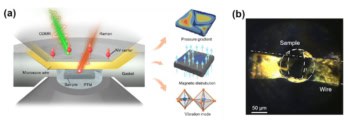The remarkably robust superconductivity of the metal alloy CeCu2Si2 has been a long-standing mystery to condensed-matter physicists. For a start, this material is able to behave as a superconductor despite having strong magnetic properties. However, it appears that the mystery of CeCu2Si2 (cerium–copper–silicon) has now been solved. Groups at the Max Planck Institute for Chemical Physics of Solids in Dresden, Germany, and the University of Geneva, Switzerland, have shown that the unique stability of superconductivity in CeCu2Si2 is a result of two distinct quantum critical points that are located close together.
Superconductivity was first discovered in CeCu2Si2 in 1979 by Frank Steglich, who now leads the Dresden group. His discovery ignited research into the physics of “heavy fermion” metals, which are a class of alloys that usually involve cerium or uranium. At low temperatures these metals have bizarre properties that would be expected if their electrons were tens or hundreds of times heavier than they are in free space.
Heavy-fermion metals are typically found near the boundary between a magnetically ordered state and a non-magnetic state, and at first the mystery of CeCu2Si2 was that superconductivity was appearing in a metal with strong magnetic signatures. In all of the superconductors known at the time, magnetism and superconductivity were mortal enemies, so CeCu2Si2 seemed to violate a fundamental property of superconductivity.
Further heavy-fermion metals were subsequently discovered, and it emerged that superconductivity is actually a rare phenomenon in these systems. However, a magnetic metal can become a superconductor when it is exposed to high pressure, which can reduce the critical temperature at which magnetic ordering occurs to absolute zero. Around such a “quantum critical point”, superconductivity has been seen over a small range of pressures in a few heavy-fermion metals.
In CeCu2Si2, however, the superconductivity can survive pressures of more than 5GPa above the magnetic quantum critical point, and actually gets stronger as the pressure is increased, showing a distinct peak at about 4GPa . The mystery of CeCu2Si2 therefore gradually evolved from being a question of why sperconductivity exists so close to a magnetic state, to a question of why it survives so far away from it. Indeed, the robustness of the superconductivity was seen by some as evidence that magnetism never supports superconductivity in heavy-fermion metals.
Huiqui Yuan and co-workers at Dresden have now deliberately weakened the superconductivity of CeCu2Si2 by substituting small concentrations of germanium for silicon, and found that the broad superconducting region described above resolves into two separate features. Each of these has the appearance of a superconducting dome that is associated with a quantum critical point, which strongly suggests that there is not just one but two quantum critical points in the phase diagram of CeCu2Si2 (Science 302 2104). Meanwhile, Alex Holmes and colleagues in Geneva have found key signatures of quantum-critical behaviour in the normal (i.e. non-superconducting) phase of CeCu2Si2, which again points to the existence of a second quantum critical point (Phys. Rev. B69 024508).
In the March issue of Physics World Stephen Julian at the Cavendish Lab at the University of Cambridge in the UK describes this work in more detail.



